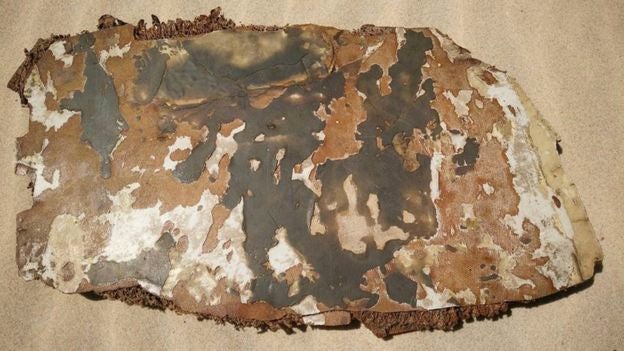MH370 latest: 'Burnt' panels among five pieces of possible debris from missing jet found on Madagascar
Discovery could have major implications for theories around how the plane disappeared

Your support helps us to tell the story
From reproductive rights to climate change to Big Tech, The Independent is on the ground when the story is developing. Whether it's investigating the financials of Elon Musk's pro-Trump PAC or producing our latest documentary, 'The A Word', which shines a light on the American women fighting for reproductive rights, we know how important it is to parse out the facts from the messaging.
At such a critical moment in US history, we need reporters on the ground. Your donation allows us to keep sending journalists to speak to both sides of the story.
The Independent is trusted by Americans across the entire political spectrum. And unlike many other quality news outlets, we choose not to lock Americans out of our reporting and analysis with paywalls. We believe quality journalism should be available to everyone, paid for by those who can afford it.
Your support makes all the difference.Five pieces of possible new debris from the missing Malaysia Airlines flight MH370 may be investigated by authorities, after two items appeared to show evidence of fire damage.
The new items washed up on beaches in Madagascar and were found by a self-styled amateur MH370 investigator, who previously found a confirmed panel from the missing plane in Mozambique.
Blaine Gibson, a US citizen, travelled to take his new finds to the Australian Transport Safety Bureau in person, after officials failed to pick them up in Madagascar.
He says two of the pieces were burnt, which would be the first time any such markings have been found on debris and could give the first indication there was a disastrous fire on board.
At a briefing for relatives of some of the 239 passengers and crew on board the missing flight, families called for the possible debris to be examined to define a new search area.
Malaysia, China and Australia agreed in July that the search in the southern Indian Ocean would be suspended after the current 120,000-square kilometre expanse has been thoroughly examined with deep sea sonar equipment in the absence of credible new evidence that identified the plane’s location.
Eight relatives of lost passengers who met with Australian officials coordinating the search on behalf of Malaysia expressed frustration that they were not given a definition of what constituted credible new evidence that would result in a continuation of the search.
Mr Gibson attended the meeting at the ATSB headquarters with the relatives from Malaysia, China, Australia and Indonesia and handed the five pieces over.
Malaysia has yet to collect other potential debris that he has found washed up on Madagascar since June and handed to authorities there.
“I hope that the search will go on and in my amateur opinion this constitutes new, credible evidence that justifies continuing the search,” he told reporters of his unconfirmed debris find.
Some confirmed pieces of debris have washed ashore in the western Indian Ocean, and the families believe other items yet to be examined may be clues to the plane’s location.
Grace Nathan, a Malaysian whose mother was on the Boeing 777 that vanished during a flight from Kuala Lumpur, Malaysia, to Beijing on 8 March, 2014, said governments should be coordinating a search for debris and using drift modelling to define a new area to search after the current search is to be completed in December.
“We want to call on the three nations – Australia, China and Malaysia – to make a concerted effort to go out and look for this credible new information,” Ms Nathan said.
“It’s very impressive that one private individual citizen, Blaine Alan Gibson, has managed to find up to 15 pieces of aircraft debris and we hope that these three nations do more than just hope by fluke people find more debris,” she added.
The ATSB confirmed in a statement that it had received debris from Mr Gibson and was seeking advice from Malaysia on how Australia should proceed.
Jennifer Chong, a Melbourne-based Malaysian-Australian dual citizen whose husband was aboard Flight 370, wondered why Malaysia had not sent diplomats to the five-hour meeting with Australian search officials. China and Indonesia both sent diplomats to support their citizens.
Oceanographers are analysing the first piece of wreckage found, a wing flap known as a flaperon that washed up on Reunion Island off the African coast in July last year – 16 months after the plane went missing – in the hope of narrowing a possible next area adjoining the current search boundary through drift modelling.
A wing flap found in Tanzania is also being examined at ATSB headquarters for clues. Search officials expect more Flight 370 wreckage to wash up in the months ahead.
Sheryl Keen, chairwoman of Air Crash Support Group, which is supporting the relatives during their week in Australia, called on Malaysia to collect the debris found by Mr Gibson on Madagascar and to consider handing responsibility for the search to Australia.
Additional reporting by the Associated Press
Join our commenting forum
Join thought-provoking conversations, follow other Independent readers and see their replies
Comments